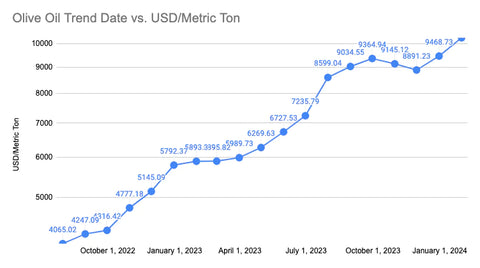As enthusiasts of olive oil, we recognize its significance beyond just a cooking ingredient—it's a cornerstone of Mediterranean cuisine and a global symbol of health. Recently, you may have noticed an uptick in the price of olive oil bottles. Let's explore the reasons behind this increase in price and the factors shaping the olive oil industry.

Global Supply Challenges: Olive oil production is highly sensitive to natural factors like weather conditions. Recent disruptions in the Mediterranean climate have affected olive yields in major producing countries like Spain, Italy, and Greece. This reduced supply has led to higher prices, with Spain's yield alone being significantly lower this year according to reports.
Shift in Consumer Demand: As people prioritize healthier eating habits, demand for olive oil has surged. This, coupled with lower crop yields, has driven prices up. Health-conscious consumers are incorporating olive oil into their daily cooking routines due to its nutritional benefits, contributing to its increased popularity worldwide.
Impact of External Factors: Olive oil prices are influenced by global events such as currency fluctuations, geopolitical tensions, and macroeconomic conditions. Changes in exchange rates can affect import and export costs, while political upheavals in producing regions can disrupt supply chains, leading to price volatility.

Quality Standards and Production Costs: Producing high-quality olive oil requires significant investments in technology, skilled labor, and infrastructure. Adhering to strict quality standards adds to production costs, ultimately contributing to higher retail prices.
Rising Transportation and Packaging Costs: Every stage of the olive oil supply chain incurs expenses, including transportation and packaging. Fluctuations in fuel prices and changes in regulations can impact costs, as can the adoption of eco-friendly packaging materials, which can be more expensive.
Impact on California Olive Oil Groves: While California produces a small portion of the global olive oil market, it focuses on premium, locally-produced oil. However, California producers face challenges like water scarcity and labor costs, and international price fluctuations can affect their competitiveness.
Impact of COVID-19: The pandemic has disrupted the olive oil industry through lockdowns, supply chain disruptions, and changes in consumer behavior. These effects continue to impact the industry, complicating the situation further.
Combatting Rising Prices: Consumers can address rising olive oil prices by supporting small businesses, local producers, and domestic sources. Cold-pressed olive oil, known for its robust flavor and longevity, can be a wise investment due to its concentrated taste, requiring less usage over time. Embracing these alternatives not only addresses budgetary concerns but also promotes sustainable food practices and fosters connections with regional food cultures.










